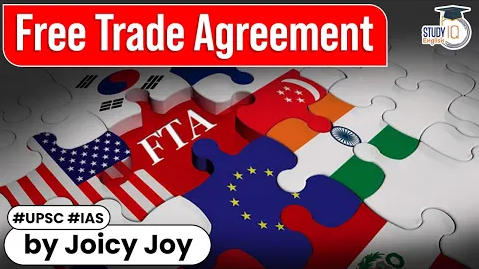Table of Contents
TRANS PACIFIC PARTNERSHIP
- US proposed FTP among 12 countries : US, Japan, Malaysia,Vietnam, Singapore, Brunei, Australia, New Zealand, Canada, Mexico, Chile and Peru.
- Aimed to have lower tariff for participant countries
- Easier norms for labour, environment and investment.
- In 2016 , US withdrew from the negotiations.
TPP-11 OR CPTPP
- Some of the nation countries came together and formed Comprehensive and Progressive Agreement for Trans-Pacific
TTIP ( TRANS ATLANTIC TRADe AND INVeSTMeNT PACT)
- Proposed FTA between USA and EU with objectives similar to TPP.
- Negotiations are still on since EU has opposed to a lot of things.
REGIONAL COMPREHENSIVE ECONOMIC PARTNERSHIP (RCEP)
- Proposed agreement between 10 ASEAN countries and their 6 FTA partners (Australia, China, India, Japan, New Zealand and S.Korea)
- Collectively these countries command 25% of Global GDP, 30% of global
- RCEP requires them to reduce tariff and non-tariff to increase investments, economic and technical cooperation, protect IPR.
- This will increase trade, economic growth, employment in these countries.
WHY DIDN’T INDIA JOIN IN NOV-2019?
- India has > $100 billion trade deficit with RCEP countries.
- Out of this China alone accounts for $54 billion.
- So India had few apprehensions like Increase flow of Chinese manufactured &electronic goods.
- Dairy products from New Zealand with longer shelf life effecting Indian farmers and dairy entrepreneurs.
- Southern Indian plantation farmers afraid of cheaper tea, coffee, rubber, cardamom and pepper from Malaysia, Indonesia etc
- India wanted an automatic Trigger Mechanism to protect itself from surge of imports.
- India wanted certain exemption from Ratchet Obligation.
- India also wanted Data localisation , the right to protect its data and prohibit cross border data flow.
- Nov 2020 :15 members signed it. India has not signed it
- 2021 : Singapore becomes 1st to Sign.
INDIA MADE A MISTAKE BY NOT JOINING RCEP?
- Competition brings excellence
- Higher taxes on exports
- Indian manufacturers could import intermediate goods from RCEP countries and re-export it to Middle east, Africa and Europe thus integrating it to the global value chain.
Indian Economy | Free PDF























 WhatsApp
WhatsApp